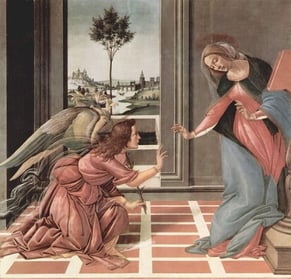 Annunciation of the Lord : April 8, 2013. Lectionary # 545. Isaiah 7:10-14. Psalm 40:7-8,8-9,10,11. Hebrews 10:4-10. (John 1:14 Alleluia vrs.) Luke 1:26-38:
Annunciation of the Lord : April 8, 2013. Lectionary # 545. Isaiah 7:10-14. Psalm 40:7-8,8-9,10,11. Hebrews 10:4-10. (John 1:14 Alleluia vrs.) Luke 1:26-38:
The title of the Feast for today is “The Annunciation of the Lord” and thus the liturgical celebration helps us keep in mind the “Christ-centeredness” of all of the New Testament. We become better marian devotees and marian students when we keep the mother Mary and her Son Jesus together in our reflections on the Scriptures. Certainly both are involved in today’s Gospel account. In fact, we hear from almost every scripture scholar that this is the most important text about Mary, the mother of Jesus. Even in the scientific commentary of the New Jerome Biblical Commentary we find this marian principle being extolled. Benedict T. Viviano, O.P. states in Matthew 2:11—the child with Mary his mother: The Magi offer a model of sound Mariology as worshippers of Christ in a Marian context.” This is the only time in the NJBC that the word Mariology appears!
Certainly we do not neglect the person of Mary in our reflections on this day as we recall her world changing YES to God through responding to the Angel Gabriel. Because of her dialoguing and reasoning with the messenger from God she will become the mother of the Messiah. Her name which has many meanings but Star of the Sea, Lady of the Sea, Gift of God are helpful. The Angel gives her a new name due to her destiny and free choice –the one who has been highly favored by God (kecharitomene).
We may wish to reflect about our Gospel by returning several times today to the Hail Mary, the favorite of our marian prayers. It comes from our Gospel reading for this day with the addition of Mary’s visit to Elizabeth who praises her with the words “Blessed are you among women and blessed is the fruit of your womb.” As for the last part of the Ave Maria (Hail Mary) it was first commented upon in a conference given by Gerilomo Savanarola (1452-1498). In his conference the Hail Mary was fully commented upon and only the word “our” before death was omitted in the Latin he had written for the young women aspiring to a religious calling. This Dominican priest was eventually hanged by the Inquisition magistrates and his body was burned in the open square of Florence. He had challenged the immorality of Alexander VI, the Medici Pope. In many ways he lived a saintly life as a Dominican who preached a very stringent morality in times of great immorality.
Recently, I guided a graduate student through a study of the Hail Mary on a book by Father Nicholas Ayo, C.S.C. a Holy Cross Father from Notre Dame who wrote an award winning book on the Ave Maria. The title of his book: “The Hail Mary: a Verbal Icon of Mary.” It is, to my knowledge, the best source for a study of the Tradition behind our most beloved prayer to Mary.
Suggested practice: Recitation of the First Joyful Mystery: The Annunciation of the Angel Gabriel to the Virgin Mary: Fruit of the Mystery: Personal Integrity. Amen.
Copyright 2013 Fr. Bertrand Buby, S.M.
About the Author

Guest
We welcome guest contributors who graciously volunteer their writing for our readers. Please support our guest writers by visiting their sites, purchasing their work, and leaving comments to thank them for sharing their gifts here on CatholicMom.com. To inquire about serving as a guest contributor, contact editor@CatholicMom.com.


.png?width=1806&height=731&name=CatholicMom_hcfm_logo1_pos_871c_2728c%20(002).png)
Comments